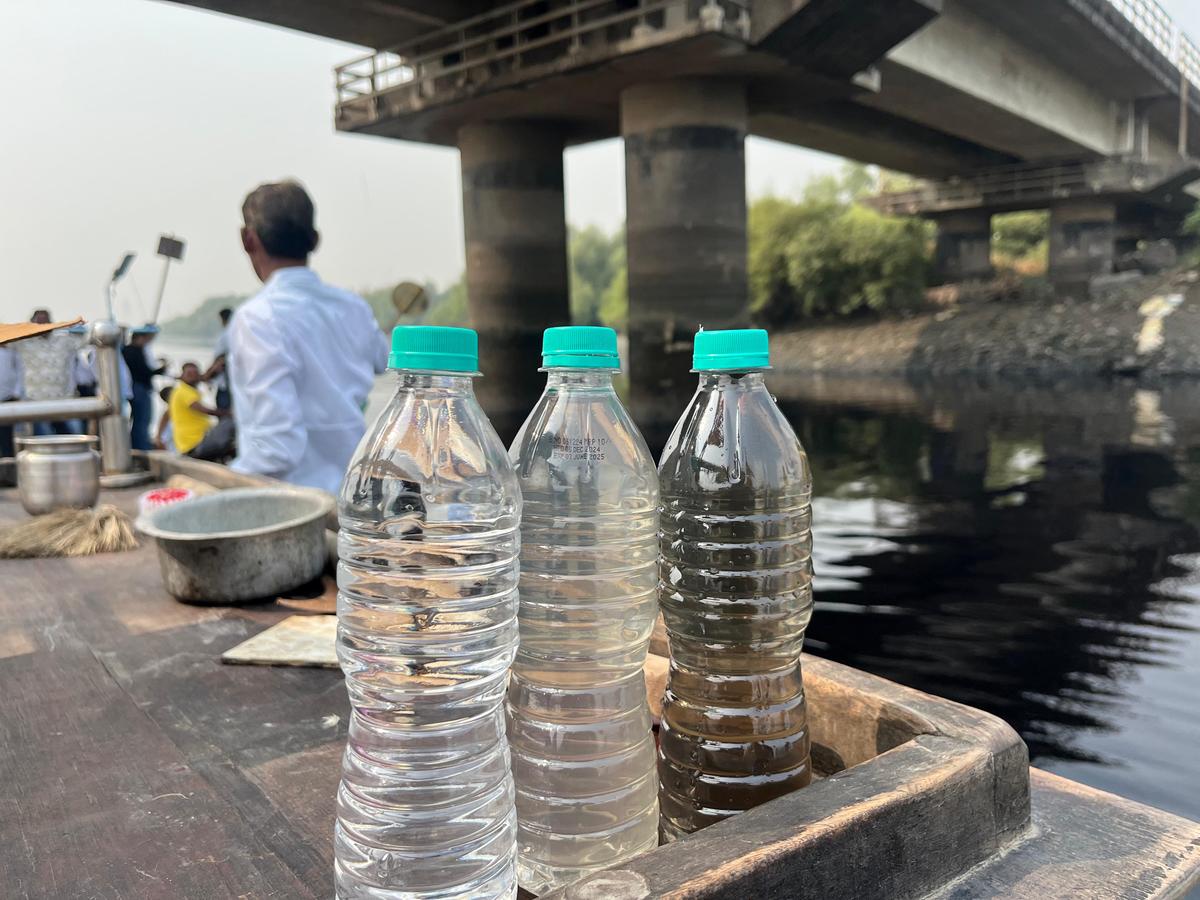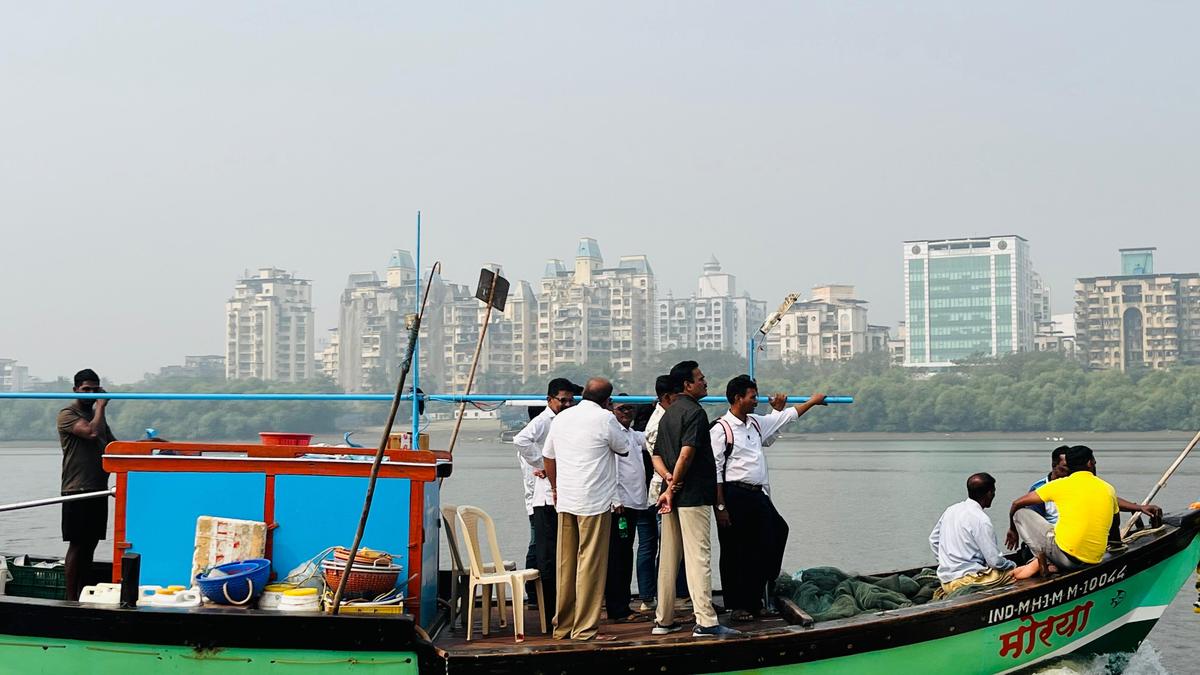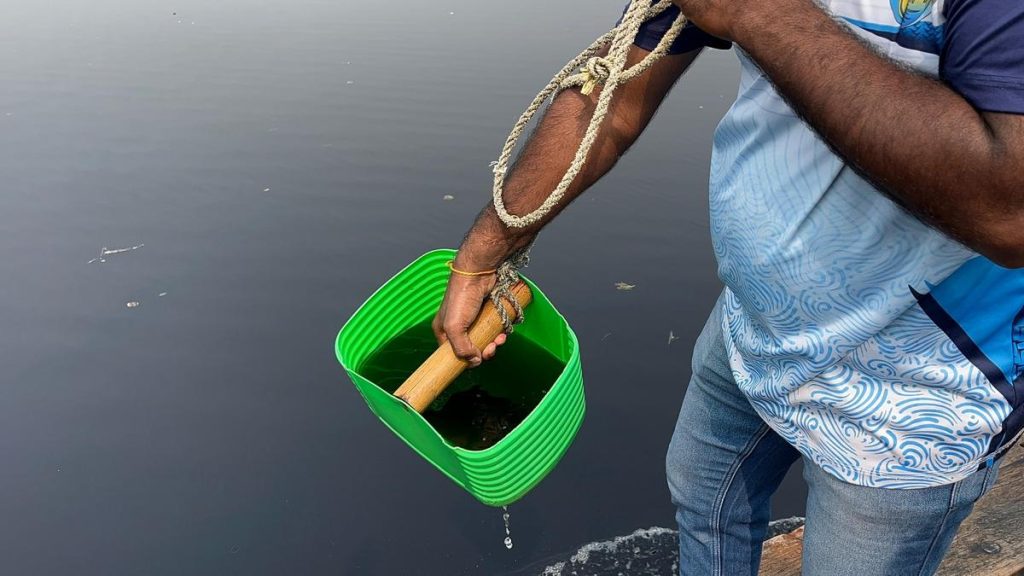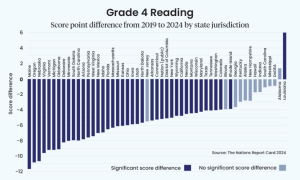Sample test reports of water bodies in Navi Mumbai reveal heavy levels of toxic chemicals in the creeks, lakes and rivers. The water bodies that are home to marine life, migratory birds and the only livelihood option for the traditional fishermen for generations, have turned black and left with only dead marine life. The traditional fishermen to approach the Bombay High Court in February with a Public Interest Litigation (PIL) petition raising concerns over the drying water bodies due to heavy industrial pollution.
The lab test report of water samples collected from lakes, creeks and rivers revealed that the appearance of the water is grey in colour; total suspended solids found 83 (milligrams per liter) mg/l whereas the normal requirement is maximum 50. Total dissolved solids observed were 17123 mg/l whereas the normal requirement is maximum 2,100. The chemical oxygen demand found was 3,470 mg/l whereas, requirement was maximum 250. The biochemical oxygen demand is found to be 1154 mg/l whereas the normal requirement cannot exceed maximum 20. Fecal coliform is recorded at 2680 mg/l whereas the maximum requirement is 1000 mg/l.

Fish Workers write to Environment board
Members of Maharashtra Small Scale Traditional Fish Workers Union wrote to the State government, fisheries department, environment department, Konkan and Raigad district administration numerous times raising the concerns of dead marine life but in vain. The complaint letter highlights fishing zones around Kharghar, Mansarowar and Diwale creek which are rich-intertidal fishing zones for hundreds of traditional fishing families for centuries.
Untreated affluents in Sea
Nandakumar Waman Pawar, environmentalist and president of the organisation said, “In the last 10 years, under the guise of development, we have permanently lost our traditional trade of fishing. Due to anthropogenic activities on the coastline, chemical units and MIDC which are operating in Navi Mumbai area have impacted all traditional fishing zones. Untreated affluents are being released directly into the middle of Diwale creek and this pipeline has been proposed to be stretched up to Belapur creek. We strongly oppose this project as we fear this will destroy Thane and Nhava Sheva creeks that merges with Arabian sea.”

Mr. Pawar has made multiple visits to assess the condition of the water bodies and has found, “The water has turned completely jet black and smells of chemicals. There is not a single living organism left; one can easily spot bubbles emerging often. We are filing a public interest litigation (PIL) at the Bombay High Court in February.”

Water sample collected from Diwale creek kept in a bottle (dark grey) to compare the level of pollution with other two bottles.
| Photo Credit:
Special Arrangement
Complaints against the industrial units
An official from Panvel Municipal Corporation (PMC) said that that they have had numerous complaints against the industrial units that are set up around the water bodies that are ecologically sensitive and are natural habitats for migratory birds.
There are about 3,254 industrial units of various category engaged in the manufacturing of chemicals, dyes, dye-intermediates, bulk drugs, pharmaceuticals, textile auxiliaries, pesticides, petrochemicals, textile processors, engineering units etc. PMC official said that they had run several water quality tests from several water bodies including Diwale creek and they had found the water to be acidic in nature, enough to destroy living organisms in the waterbodies.
“Last year, during monsoon, the industries released extremely toxic untreated waste, highly acidic in nature that over thousands of fish were floating dead in the creeks of Navi Mumbai. It is a fact that the water of the creeks has turned black, they are highly polluted so you cannot find a single life in them anymore. We have approached MCPB and Maharashtra Industrial Development Corporation (MIDC) numerous times with these concerns, but they do not act upon it. We have limited powers; we can only act when someone complains against these activities and it is often that they are the fishing communities who live around these creeks reach out to us,” PMC official said.
Struggle of traditional fisherman
Traditional fisherman Akash Nirvutti Koli (38) from Diwale village, who lives with his wife, two children and mother, has been struggling to earn money as there are no fish left. “Kolis are the original inhabitants of this region, and all kinds of steps are taken to eradicate our existence by directly hammering on our sole livelihood option, fishing. Diwale creek used to have an abundance of fish and greenery around. Today it smells of dead with only jet-black water in the creek. Until last year, we could often see dead fishes floating in the creek now no living organism is left. The industries in and around the creeks have killed our turned into sewage water. It stinks, it is black and smells of death. All the industries have killed our water resources slowly with the toxic chemicals they discharge into them.”
Diwale village used to have around 10,000 fishermen 15 years ago. Today, all have been struggling to continue fishing as their source of livelihood are now slowly taking up jobs as house help, security guards and those who have retained the profession, have been purchasing ocean fish to sell.
“At least 6000 of us continue to fish but it takes a lot of time and investment as we have to look for fish in multiple water bodies. Some days we go towards Elephenta, some days we wander in the creeks of Vashi, both take us around 2 hours to reach each location with no guarantee. My two brothers have given up on traditional fishing and now only buy sea fish from Mumbai and see in the villages,” Akash said.
“All marine life is dead”
Dnyaneshwar Koli (53) quit fishing 15 years ago as he was not able to raise his two children. “Due to heavy pollution, all marine life is dead. I had several skin allergies every time I ventured into the creeks as they were mixed with toxic chemicals. I now work as an operator in a telecom company as I could study till class 10. My wife continues to sell fish. She leaves home at 4am to take the train to reach Dockyard Road to buy fresh sea fish and roams around till evening selling fish. She comes home only by 9pm.” His daughter and son work in private companies.

Traditional fishermen along with a team of water testing officials inspect the water bodies in Navi Mumbai.
| Photo Credit:
Special Arrangement
Declining fishing zones
An official from the Department of Fisheries said, “Maharashtra Pollution Control Board (MCPB) has an important role to play in monitoring the pollution levels of water bodies. Strict action should be taken against those who are polluting the fishing zones and catchment areas. We have been raising concerns about the declining fishing zones for years, but it is not just in our power to save the water bodies. The higher authorities in the State and Centre are the ultimate decision makers. The fisheries department is struggling to address this crisis across Maharashtra and India.”
An official from MCPB refused to accept the argument of water pollution and said that for the past three months, MIDC has started the pipeline extension work and it is their responsibility to shift the disposal point. “We have been constantly monitoring the water quality level and in the past three months, we have not come across any such incidents of chemical effluents being discharged into water bodies. The current chemical oxygen demand (COD) is a water quality parameter that measures the amount of oxygen required to oxidize organic substances in water is also well within the compliance.”
Published – February 02, 2025 07:13 pm IST






